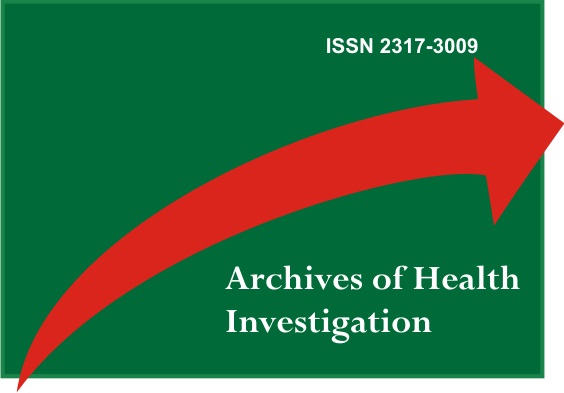Fluorosis prevalence and fluoride concentration in drinking water
DOI:
https://doi.org/10.21270/archi.v10i6.5011Keywords:
Fluorosis, Dental, Fluorine, Sodium Fluoride, Epidemiology, Drinking WaterAbstract
Introduction: In dentistry the fluorine ion – also known as fluoride – shows prophylactic and therapeutic effects but it can also present risks. Its use in public water supply and other products should be understood and controlled in order to minimize unwanted effects on dentitions, such as dental fluorosis. The monitoring of dental fluorosis in a country is important to verify whether figures are stabilized, once a growing global immigration potential is known. Objective: To carry out a literature review of the last years, searching for information about the relations between fluoride concentration in drinking water and the prevalence of fluorosis in various populations of different countries. Materials and Methods: Was sought publications in the main databases: Scopus, Portal Periódicos Capes, Scielo, Virtual Health Library, PubMed and Google Scholar, using the following keywords: Dental fluorosis, Fluorine, Fluoride, Epidemiology and Drinking Water, in Portuguese, Spanish and English. Of the 38 articles selected, 29 were used in this study. Results: Of the countries studied, Ethiopia (with 12 parts per million of fluorine in drinking water) obtained the highest index of dental fluorosis (100% of the sample) while the lowest fluorosis index was found in Syria (1.39 parts per million of fluorine in drinking water), equivalent to 15%. Conclusion: It can be concluded from this study that the prevalence and severity of dental fluorosis are generally higher in populations living in regions with high concentrations of fluoride in drinking water, since it is considered the main natural source of fluorine ion in many communities.
Downloads
References
Petersen PE, Lennon MA. Effective use of fluorides for the prevention of dental caries in the 21st century: the WHO approach. Community Dent Oral Epidemiol. 2004;32(5):319-21.
Leal SD, De Carvalho FS, De Carvalho CAP. Conhecimento de alunos do Curso de Odontologia sobre o uso racional do flúor. Rev Odontol da UNESP. 2015;44(1):51-8.
Ferreira RGLA, Bógus CM, Marques RA de A, Menezes LMB de, Narvai PC. Fluoretação das águas de abastecimento público no Brasil: o olhar de lideranças de saúde. Cad Saude Publica. 2014;30(9):1884-90.
Horowitz HS. Fluoride and enamel defects. Adv Dent Res. 1989;3(2):143-46.
Kebede A, Retta N, Abuye C, Whiting SJ, Kassaw M, Zeru T et al. Dietary fluoride intake and associated skeletal and dental fluorosis in school age children in rural Ethiopian Rift Valley. Int J Environ Res Public Health. 2016;13(8):1-10.
Grøn P, McCann HG, Brudevold F. The direct determination of fluoride in human saliva by a fluoride electrode. Fluoride levels in parotid saliva after ingestion of single doses of sodium fluoride. Arch Oral Biol. 1968;13(2):203-13.
Benazzi AS, Da Silva RP, De Meneghim M, Ambrosano GM, Pereira AC. Dental caries and fluorosis prevalence and their relationship with socioeconomic and behavioural variables among 12-year-old schoolchildren. Oral Health Prev Dent. 2012;10(1):65-73.
Fejerskov O, Larsen MJ, Richards A, Baelum V. Dental tissue effects of fluoride. Adv Dent Res. 1994;8(1):15-31.
de Carvalho RB, Medeiros UV, dos Santos KT, Pacheco Filho AC. Influência de diferentes concentrações de flúor na água em indicadores epidemiológicos de saúde/doença bucal [Influence of different concentrations of fluoride in the water on epidemiologic indicators of oral health/disease]. Cien Saude Colet. 2011;16(8):3509-18.
Costa S de M. Cárie dentária e fluorose endêmica em distritos rurais de Minas Gerais, Brasil. Rev Bras Epidemiol. 2013;16(4):1021-28.
Organização Mundial da Saúde. OMS. Levantamentos em Saúde Bucal: Métodos Básicos. 5. ed. São Paulo: Faculdade de Odontologia da USP; 2013.
Dean HT. The investigation of physiological effects by the epidemiological method. In: Moulton FR, editor. Fluorine and dental health. Washington (DC): Am Assoc Adv Sci; 1942. p.23-31.
Wondwossen F, Åstrøm AN, Bjorvatn K, Bårdsen A. The relationship between dental caries and dental fluorosis in areas with moderate- and high-fluoride drinking water in Ethiopia. Community Dent Oral Epidemiol. 2004;32(5):337-44.
Bermúdez JM, Peraferrer GR, Català AG. ¿Debemos administrar suplementos orales de flúor a los lactantes ? An Esp Pediatr. 1996;45(3):236-41.
Dean HT, Jay F, Arnold FA, Elvove E. Domestic water and dental caries: ii. a study of 2,832 white children, aged 12-14 years, of 8 suburban chicago communities, including lactobacillus acidophilus studies of 1,761 children. Pub Health Rep. 1941;56:761-92.
Heller KE, Eklund SA, Burt BA. Dental caries and dental fluorosis at varying water fluoride concentrations. J Public Health Dent. 1997; 57(3):136-43.
Almerich-Silla JM, Montiel-Company JM, Ruiz-Miravet A. Caries and dental fluorosis in a western Saharan population of refugee children. Eur J Oral Sci. 2008;116(6):512-17.
Beiruti N, van Palenstein Helderman WH. Oral health in Syria. Int Dent J. 2004;54(6 Suppl 1):383-88.
Riatto SG, Montero J, Pérez DR, Castaño-Séiquer A, Dib A. Oral Health Status of Syrian Children in the Refugee Center of Melilla, Spain. Int J Dent. 2018;2018:2637508.
Varenne B, Petersen PE, Ouattara S. Oral health status of children and adults in urban and rural areas of Burkina Faso, Africa. Int Dent J. 2004;54(2):83-9.
Mazza C, Strohmenger L, Campus G, Cagetti MG, Caruso F, Petersen PE. Oral health status of children living in gorom-gorom, oudalan district, burkina faso. Int J Dent. 2010;2010:597251.
Maatouk F, Jmour B, Ghedira K, Argoubi K, Abid A. Dental fluorosis in Kairouan, Tunisia. Dent News (Lond). 1998;1:17-9.
Abid A. Oral health in Tunisia. Int Dent J. 2004; 54(6 Suppl 1):389-94.
Llodra-Calvo JC. Encuesta de Salud Oral en España 2010. RCOE. 2012;17(1):13-41.
Llodra-Calvo JC. Influencia del origen de nacimiento (España versus extranjero) en la Salud Oral de la población infanto-juvenil en España 2010. RCOE. 2012;17(1):47-61.
Vitória I, Maraver F, Almerich-Silla JM. Flúor en aguas de consumo público españolas y prevención de la caries dental. Gac Sanit. 2014;28(3):253–59.
Brasil. Ministério da Saúde. Secretaria de Vigilância em Saúde. SB Brasil 2010: Pesquisa Nacional de Saúde Bucal. Resolução nº 196/96 de 7 de Janeiro de 2010. Editora MS. 2012. 116 p.
Paixão PJ, Arthur W, Valente S, Roberto P, Camuri N, Munhoz T, et al. Análise da concentração de fluoretos em águas minerais disponíveis no Rio de Janeiro. Arq Bras Odontol. 2013;9(1):1-6.


